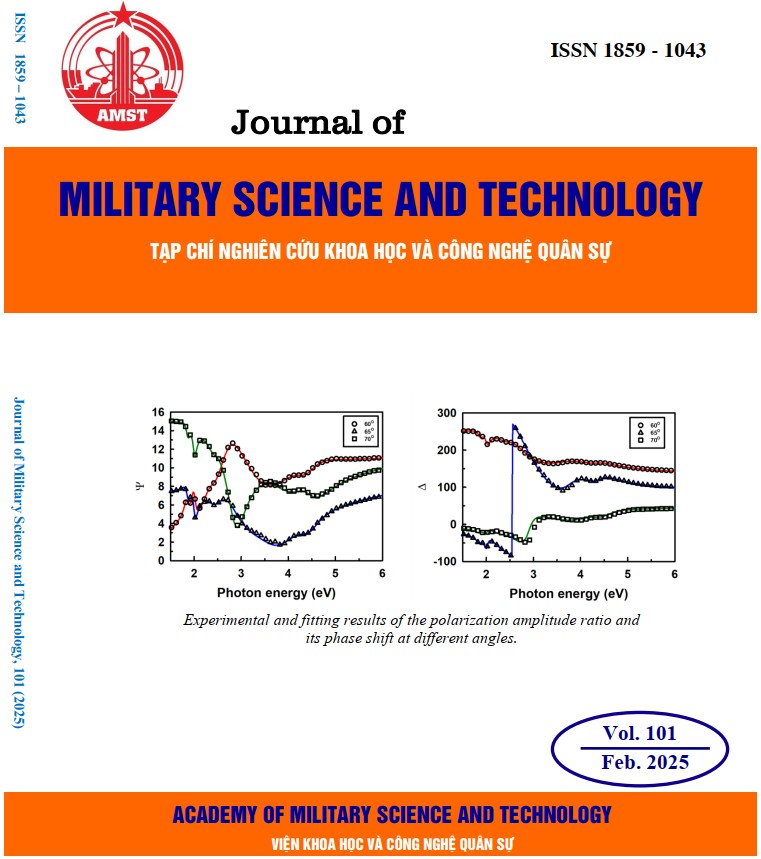Điều khiển trượt dựa trên học tăng cường trong điều khiển bám quỹ đạo của máy bay không người lái dưới các nhiễu bất định
886 lượt xemDOI:
https://doi.org/10.54939/1859-1043.j.mst.101.2025.39-46Từ khóa:
Học tăng cường (RL); Cấu trúc Actor/Critic; Điều khiển trượt (SMC); Điều khiển tối ưu; Máy bay không người lái 4 cánh (QUAV).Tóm tắt
Bài báo đề xuất phương pháp điều khiển trượt (SMC) dựa trên học tăng cường (RL) để điều khiển bám quỹ đạo của quadrotor UAV (QUAV) dưới tác động của nhiễu bên ngoài. Đầu tiên, một bộ điều khiển trượt dựa trên học tăng cường actor-critic (actor-critic RL) được giới thiệu để giải quyết bài toán điều khiển tối ưu trong điều kiện không có nhiễu. Tiếp theo, mô phỏng trong môi trường có nhiễu được thực hiện nhằm chứng minh tính bền vững của bộ điều khiển được đề xuất. Phân tích lý thuyết cho thấy sai số vị trí và góc của UAV hội tụ về một miền đặt trước, trong khi sai số ước lượng của mạng actor-critic được giới hạn cuối cùng một cách thống nhất (uniformly ultimately bounded - UUB). Cuối cùng, một phân tích so sánh mô phỏng số giữa bộ điều khiển đề xuất, bộ điều khiển trượt truyền thống và bộ điều khiển trượt kết hợp kỹ thuật Backstepping (BSP) được thực hiện để làm rõ các ưu điểm và hiệu suất cải thiện của SMC dựa trên RL.
Tài liệu tham khảo
[1]. Mohsan, Syed Agha Hassnain, et al. "Unmanned aerial vehicles (UAVs): Practical aspects, applications, open challenges, security issues, and future trends." Intelligent Service Robotics, 16.1, 109-137, (2023). DOI: https://doi.org/10.1007/s11370-022-00452-4
[2]. Liu, Hui, et al. "Reinforcement learning‐based tracking control for a quadrotor unmanned aerial vehicle under external disturbances." International Journal of Robust and Nonlinear Control, 33.17, 10360-10377, (2023). DOI: https://doi.org/10.1002/rnc.6334
[3]. Li, Bo, et al. "Fixed-time integral sliding mode control of a high-order nonlinear system." Nonlinear Dynamics, 107, 909-920, (2022). DOI: https://doi.org/10.1007/s11071-021-06984-1
[4]. Qi, Wenhai, Guangdeng Zong, and Wei Xing Zheng. "Adaptive event-triggered SMC for stochastic switching systems with semi-Markov process and application to boost converter circuit model." IEEE Transactions on Circuits and Systems I: Regular Papers, 68.2, 786-796, (2020). DOI: https://doi.org/10.1109/TCSI.2020.3036847
[5]. Yong, Jiongmin, et al. "Dynamic programming and HJB equations." Stochastic controls: Hamiltonian systems and HJB equations, 157-215, (1999). DOI: https://doi.org/10.1007/978-1-4612-1466-3_4
[6]. Evans, L. C., and M. R. James. "The Hamiltonian–Jacobi–Bellman equation for time-optimal control." SIAM journal on control and optimization, 27.6, 1477-1489, (1989). DOI: https://doi.org/10.1137/0327076
[7]. Werbos, Paul. "Approximate dynamic programming for real-time control and neural modeling." Handbook of intelligent control, (1992).
[8]. Vamvoudakis, Kyriakos G., and Frank L. Lewis. "Online actor-critic algorithm to solve the continuous-time infinite horizon optimal control problem." Automatica, 46.5, 878-888, (2010). DOI: https://doi.org/10.1016/j.automatica.2010.02.018
[9]. Ma, Zhiqiang, Panfeng Huang, and Yuxin Lin. "Learning-based sliding-mode control for underactuated deployment of tethered space robot with limited input." IEEE Transactions on Aerospace and Electronic Systems, 58.3, 2026-2038, (2021). DOI: https://doi.org/10.1109/TAES.2021.3126569
[10]. Modares, Hamidreza, Mohammad-Bagher Naghibi Sistani, and Frank L. Lewis. "A policy iteration approach to online optimal control of continuous-time constrained-input systems." ISA transactions, 52.5, 611-621, (2013). DOI: https://doi.org/10.1016/j.isatra.2013.04.004
[11]. Tan, Jian, and Shijun Guo. "Backstepping control with fixed-time prescribed performance for fixed wing UAV under model uncertainties and external disturbances." International Journal of Control, 95.4, 934-951, (2022). DOI: https://doi.org/10.1080/00207179.2020.1831700
[12]. Wen, Guoxing, et al. "Optimized backstepping tracking control using reinforcement learning for quadrotor unmanned aerial vehicle system." IEEE Transactions on Systems, Man, and Cybernetics: Systems, 52.8, 5004-5015, (2021). DOI: https://doi.org/10.1109/TSMC.2021.3112688
[13]. Xu, Shihao, et al. "Reinforcement-learning-based tracking control with fixed-time prescribed performance for reusable launch vehicle under input constraints." Applied Sciences, 12.15, 7436, (2022). DOI: https://doi.org/10.3390/app12157436
[14]. Nguyen, H. S., et al. "Advanced Motion Control of a Quadrotor Unmanned Aerial Vehicle based on Extended State Observer." International Conference on System Science and Engineering. IEEE, (2023). DOI: https://doi.org/10.1109/ICSSE58758.2023.10227212
[15]. Liu, K., Wang, R., Zheng, S., Dong, S., & Sun, G. "Fixed-time disturbance observer-based robust fault-tolerant tracking control for uncertain quadrotor UAV subject to input delay". Nonlinear Dynamics, 107(3), 2363-2390, (2022). DOI: https://doi.org/10.1007/s11071-021-07080-0
[16]. Chen, Fuyang, et al. "Robust backstepping sliding-mode control and observer-based fault estimation for a quadrotor UAV." IEEE Transactions on Industrial Electronics, 63.8, 5044-5056, (2016). DOI: https://doi.org/10.1109/TIE.2016.2552151
[17]. Tan, Lingwei, et al. "Super-twisting sliding mode control with defined boundary layer for chattering reduction of permanent magnet linear synchronous motor." Journal of Mechanical Science and Technology, 35: 1829-1840, (2021). DOI: https://doi.org/10.1007/s12206-021-0403-9







